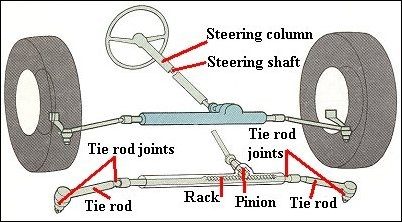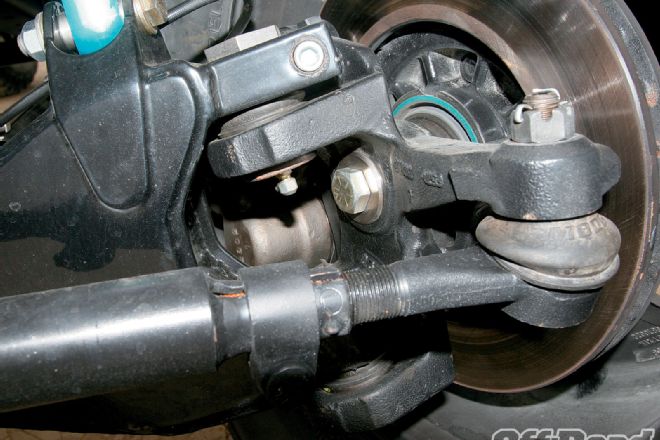Hi LogiForce,
i stumbled accross your great post here, and hoped you might help me with a question that puzzles me since a long time:
Does pCars' FFB system "weights" the Mz force as a part of the Fxyzm matrix in terms of being also one of those tireforces happening at the tire contact patch (i.e., e.g. acc. to Pacejka...), OR does Mz represent the torque at the (imaginary) steering axis, that is very depending on caster and KPI?
I'm aware that the scrub radius as a result of caster and kingpin inclination has an impact to the tireforce Mz at tire contact patch as well, but as far as i know the absolute Mz force (at tire patch) is much less strong than Mz torque forces resulting from force translations where mainly Fy and Fx translate into a torque caused by the geometry force effects due to the scrub radius.
In other words: When i dial in Mz settings in the in-car FFB matrix, does the FFB system computates and weights the "weak" Mz forces of contact tire patch, or the "strong" Mz forces that happen at the steering axis, eventually transformed trough rod, rack and pinion to the final torque a the steering wheel rack?
Very much looking forward to an answer, since this could explain some pCars FFB characteristics that i still can't fully "rationalize".
the question is in so far interesting too, because i always wondered on which basis the devs decided if Fz shall 'counteract' (pull into corner) or the other way round. my only guessing was so far, that they made it depending on positive or negative scrub radius, but my assumption doesn't correlate with what i feel when isolate Mz (by setting all other in car tire forces to zero).
Hi tennenbaum,
The quick answer is that it does do that. It's part of the tyre forces as below.
The thing is that if you add an inclination to the kingpin via caster angle, than you create a situation where you have to push or pull the tyre upwards. Cause at 0 degree caster, so a straight verticle kingpin angle, the tyre only has to rotate around the verticle kingpin that is placed on the inside of the tyre. How much around depends on the ET value of your rims, so the offset of the rims, plus the distance from the brake disc surface to the center of the kingpin.
So this offset will also play a roll in how much scrub/resistance you'll face at 0 degree caster and camber.
Now when you slant the kingpin by adding caster, your tyre still has to rotate around that kingpin but it also has to rotate upwards. This will add a dynamic camber while turning. Cause as the wheel rotates the outside of the tyre either gets raised off of the ground or gets pushed into the ground.
This is also why when you turn some cars to full lock you'll see that the car raises up a bit. So if you ever wondered why a kart or a car does that... caster angle dynamically changing the camber angle is the answer.
Also angling the kingpin of course means that the contact patch will be moved 'backwards a bit'. In other words, it's further away from the bottom end of the kingpin. Other than directly beneath it when the kingpin is perfectly verticle.
A nice example of the raising of a car at full lock is in this following RC video...
Back to pCARS. So Mz represents the turning moment of the tyre around the kingpin, and thus is directly influenced by both caster and camber. Which is also part of the other forces. Cause the Fy (lateral force) obviously will also try to push the tyre away... up and around that angled kingpin.
Now Fx (directional force) will oppose Fy by nature as it wishes to keep the wheel moving in the direction of travel, while the lateral force tries to change the direction due to its side impacting nature.
Personally I like to keep these values equal because they oppose each other. If you start to mess with them, than basically you change the impact of the physics engine upon itself, cause the FFB motor directly changes the position of the wheels via the position sensor in your steering wheel. So anything that alters the weight of the tyre forces, alters the physics in a sense through the FFB wheel that feeds back into the game engine.
That said... you could basically say that Mz is kind of a volume knob for your caster, that increases or decreases the gain on Fx and Fy coming through. But again... I am of the opinion that all these forces should be in equilibrium with each other.
Fz is the normal force... so gravity and any other verticle forces that act upon the tyre. Gravity is of course also something that shouldn't be put out of whack.
So all in all, Mz Fxyz... leave them at equal levels for natural feedback from the game. If the game thus doesn't feel natural, it must be something in either the tyre physics or suspension geometry causing it to feel wrong.
Now that we know Mz and Fxyz... onto the next bit of your question. Why does the translation differ from the contact patch strength. Simple... leverage!
In the above you see a steering knuckle with a brake disc on it. The kingpin in this case exists out of two ball joints, an upper and lower ball joint.
Now the import bit is that metal rod in front of the camera. That's the tie-rod with the tie-rod end, which is attached to the steering arm. Yes, that same arm you can change the angle of in the FFB settings in the vehicle setup screen.
So basically the "arm angle" setting in the game let's you allow to change the construction of that steering knuckle, and to be precise... the angle of its steering arm. So it let's you alter the leverage you'll have on the tyre. Which will make it harder or easier to push the tyre up and around the angled kingpin due to caster settings.

As for calculating the 'weights'. Of course it does this, but it doesn't limit the dynamic range of the final result, but there are options to do that within the FFB settings as well.
The problem is that most consumer wheels don't have enough dynamic range in terms of torque from their FFB motors to deliver the right amounts of difference of 'heavy and light feel'. Which means that even when your wheel starts clipping at heavy load, you might feel too lightly when just driving casually.
Using this will let you alter the feel without changing the balance of Mz and Fxyz in an unfavorable way if necessary for your steering wheel.
I almost forgot your last question about Fz. I don't know what they see as positive or negative, but as Fz is the normal force (which includes gravity) than it means that it can't just "pull into a corner on its own".
What this means is that even though the forces from Mz and Fx and Fy don't come through, it doesn't mean that the physics don't calculate the change in suspension geometry based on car settings (caster, camber, toe). As well as the angle of your steering arm of course.
So these dynamic changes determin the pull you might feel. It's (I think) the weight of the car that tries to pull the tyre into a situation where it is running level with the ground again.
The thing is... you don't want it to pull into the corner. You want car to be pulled into a straight line direction. If the wheel pulls into the corner, the forces might go into negative. So if gravity increases the direction of which the steering wheel rotates by force is changed torwards steering lock instead of steering center.
So if you test Fz... it always has to return to the lowest center of gravity point. Cause remember... if you have Mz + Caster angle... the car will lift at lock and thus raise its center of gravity.
I hope this will answer some of your questions, cause I somewhere got lost myself in trying to answer them.

Sorry
Important edit after testing
I just did some testing after brain storming the above and figuring out what's positive or negative, but it seems SMS has mixed up the positive and negative of the Fz (verticle acting normal force).
The following test was done with the BAC Mono at Bannochbrae (or however you spell it

):
I put Mz, Fx and Fy at 0 in the options and than set Fz to 200 (max).
When I turned the wheel with the car with the above settings I noticed something. It felt as if there was a 'hump' in the middle and the FFB rolled either off of it towards full lock on either the left or right side.
You've guessed it right. It's as if the FFB is inverted! Well... it is!
I will report this internally as an ex-WMD member. For now use FFBTweakers as PC users... console users will need to wait as you can't invert Mz or Fxyz via the in-game menu.
I used the following tweaker on my CSWv2 with default tuning menu settings (for 100, spr 100, dpr 100... etc).
There was no clipping, but there was no deadzone and the wheel felt properly heavy. Also I could properly feel the effect of humps and bumps at Bannochbrae. Plus opposite lock came on far more natural.
Code:
<?xml version="1.0" encoding="utf-8" ?>
<!-- Default force feedback tweakers. -->
<config>
<value TopologyVersion="4" />
<value SpindleMasterScale="0.26" />
<value SpindleArm="5.0" />
<value SpindleFxScale="1.0" />
<value SpindleFxLoPass="0.0" />
<value SpindleFyScale="1.0" />
<value SpindleFyLoPass="0.0" />
<value SpindleFzScale="-1.0" />
<value SpindleFzLoPass="0.0" />
<value SpindleMzScale="1.0" />
<value SpindleMzLoPass="0.0" />
<value SoPScale="0.0" />
<value SoPLateral="0.0" />
<value SoPDifferential="0.0" />
<value SoPLoPass="0.0" />
<value RelativeGain="0.0" />
<value RelativeBleed="0.0" />
<value RelativeClamp="0.0" />
<value ArmScale="0.0" />
<value ArmMass="0.0" />
<value ArmStiffness="0.0" />
<value ArmDamping="0.0" />
<value GutScale="0.0" />
<value GutLongScale="0.0" />
<value GutMass="0.0" />
<value GutStiffness="0.0" />
<value GutDamping="0.0" />
<value ScoopKnee="0.0" />
<value ScoopReduction="0.0" />
<value TightenCenterRange="0.0" />
<value TightenCenterFalloff="0.0" />
<value SoftClip="0.0" />
<value BaseDrag="0.0" />
<value BaseDragSqr="0.0" />
<value BaseDragLoPass="0.0" />
<value DisableDynamicSpring="true" />
<value DisableLockSpring="false" />
<value DisableScrub="true" />
<value DisableThrottleVibe="true" />
<value DisableJolt="true" />
<value DisableWheelSpin="true" />
<value DisableGearChange="true" />
<value DisableRumbleStrip="true" />
</config>





 Sorry
Sorry ):
):